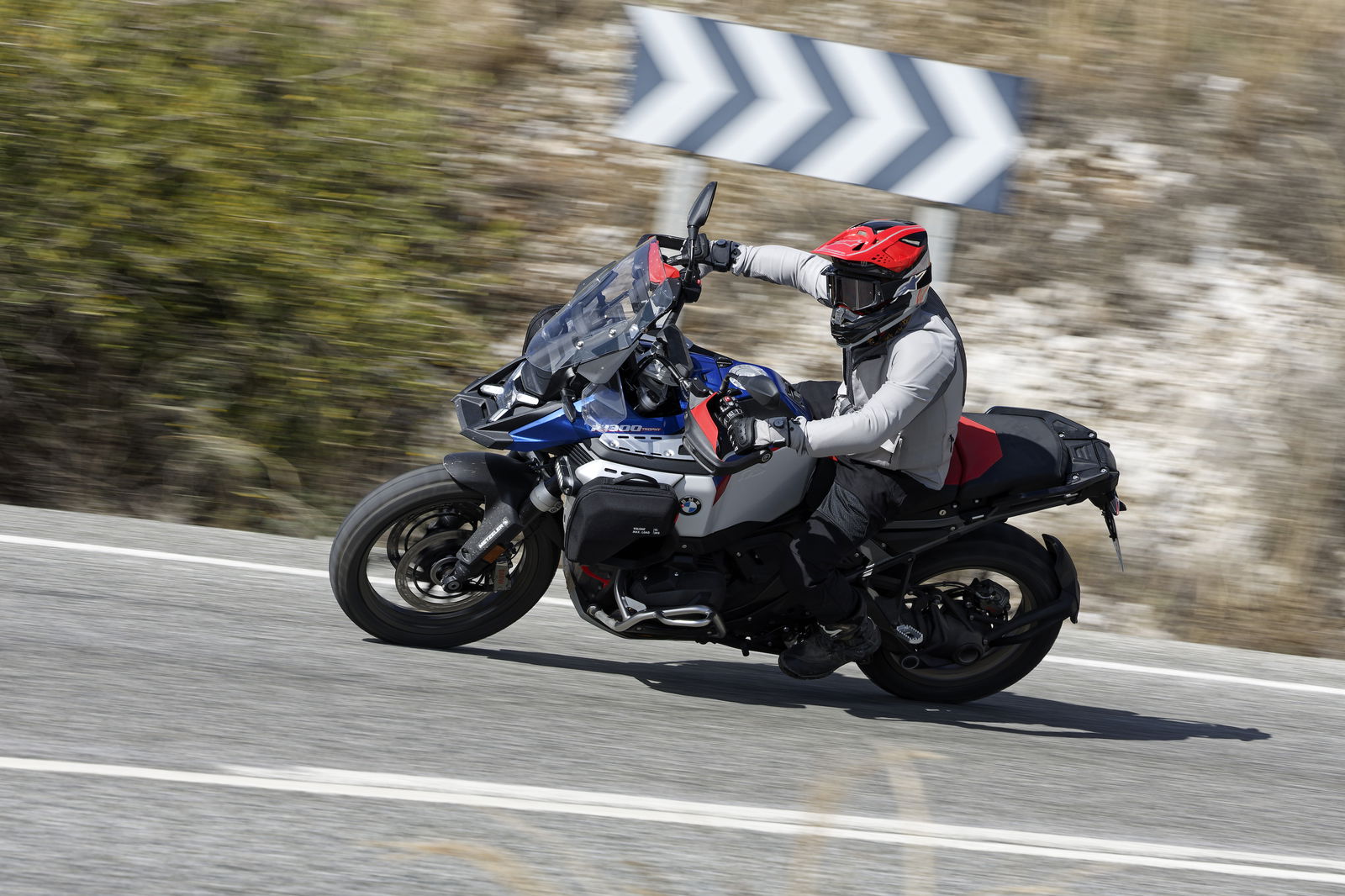2025 Ducati Multistrada V4 S review: Super Fast Touring Just Got Easier
Ducati has updated its do-it-all Multistrada V4 for 2025, with a host of new technologies headlining the updates

If you asked me to name 40 things that Ducati needed to do to improve its Multistrada V4, I’d be extremely hard pushed to come up with that many points.
Nevertheless, I managed to note 40 points of change for the 2025 model year. And that’s only the ones I noted, I could have missed a few more. Like any manufacturer, Ducati isn’t resting on its laurels with its best-seller, and while its styling means it looks very much like the outgoing bike, beneath the skin there’s a hell of a lot of new stuff going on.
For the press launch of the new Multistrada V4, we rode the top-spec S version on-road and off-road. The bike used for the 10 mile off-road element was specced with spoked wheels (21-inch front), Pirelli Scorpion STR hoops, and adventure-spec aluminium panniers. We had about 150 miles to complete, riding twisty mountain roads, fast, flowing sweepers, some motorways and about 10 miles on a gravel fire trail.

2025 Multistrada V4 S trim levels and price
Directly above the £21,495 stock bike is the Radar trim level which costs £1,000 and, you guessed it, gains the front and rear radar, blind spot detection, radar-assisted cruise control, and the new collision warning system. Above that is Radar and Travel which costs £2,530 and further adds heated grips and seats, a centre stand, hand guards, and panniers to the bike. Opting for the Sport Travel and Radar will set you back £3,630 and includes everything above and forged rims, while the £4,130 Adventure Travel and Radar option adds aluminium panniers and the spoked rims.
The new bike comes in three colours, Ducati Red, Thrilling Black, and Arctic White.
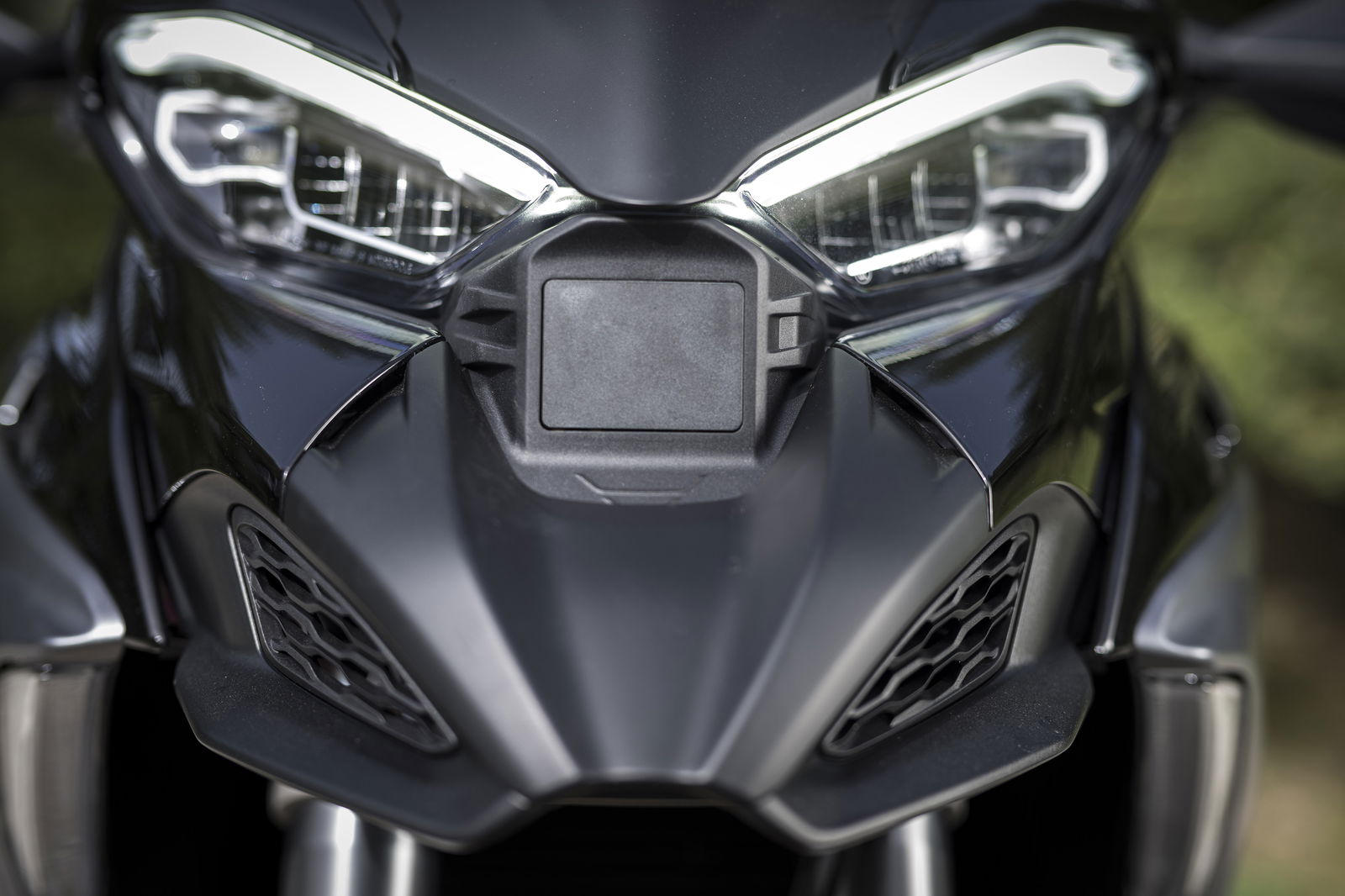
What’s new
As mentioned, quite a lot! The engine is the same, which is a good thing because it’s hard to fault the Gran Turismo V4. You still get 167bhp and 91lb ft from the 1,158cc engine, although for 2025 it’s mated to a new exhaust system that’s lighter than before and has a distinctly raspy exhaust note.
The styling has been tweaked, although it’s a subtle change. New graphics on the side panels and a redesign of the beak are really the only two things that set the new bike apart from the old. Pillions are better provided for thanks to the pannier and top-box mounts being located further rearward, while the frame is now the same grey colour as the swingarm.
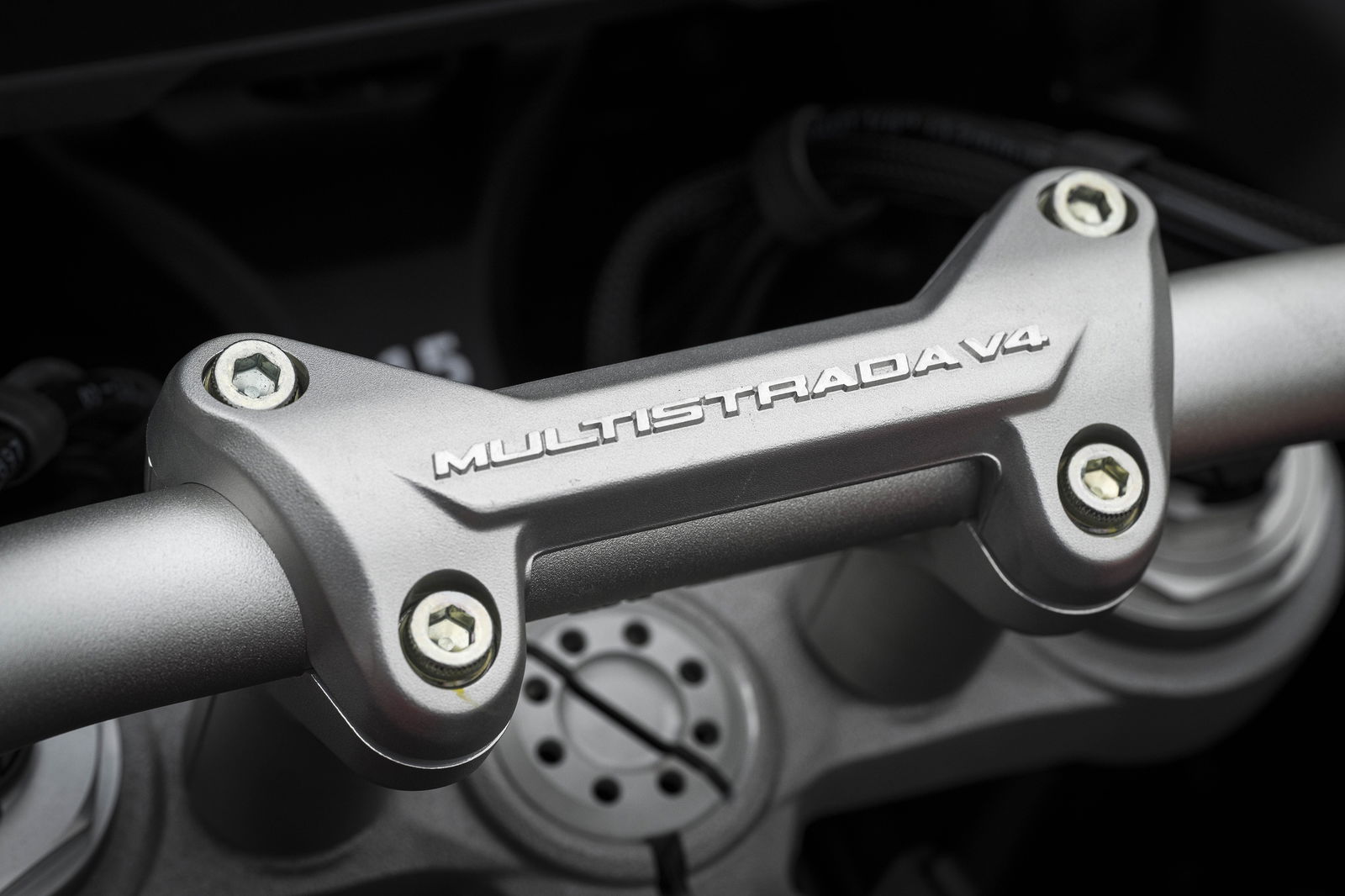
The chassis of the bike has also been upgraded, thanks to new wheel options that are lighter than before. The new forged items, which we used on the road, save 2kg, while the spoked adventure-spec wheels are also lighter than those available for the 2024 edition.
Further chassis enhancements include a swingarm pivot mounted 1mm higher than before to help reduce squat when accelerating, while the rear brake disc is bigger than before and mated to a new caliper and master cylinder with a more aggressive ratio. Another big change, and one that seems to be a world first, is the inclusion of a combined braking system (CBS) that works in the conventional manner and in reverse. Like an existing CBS, pressing the front brake will send some brake pressure to the rear wheel, although when the bike is in ABS mode 3, pressing the rear brake will send a small amount of pressure to the front wheel.
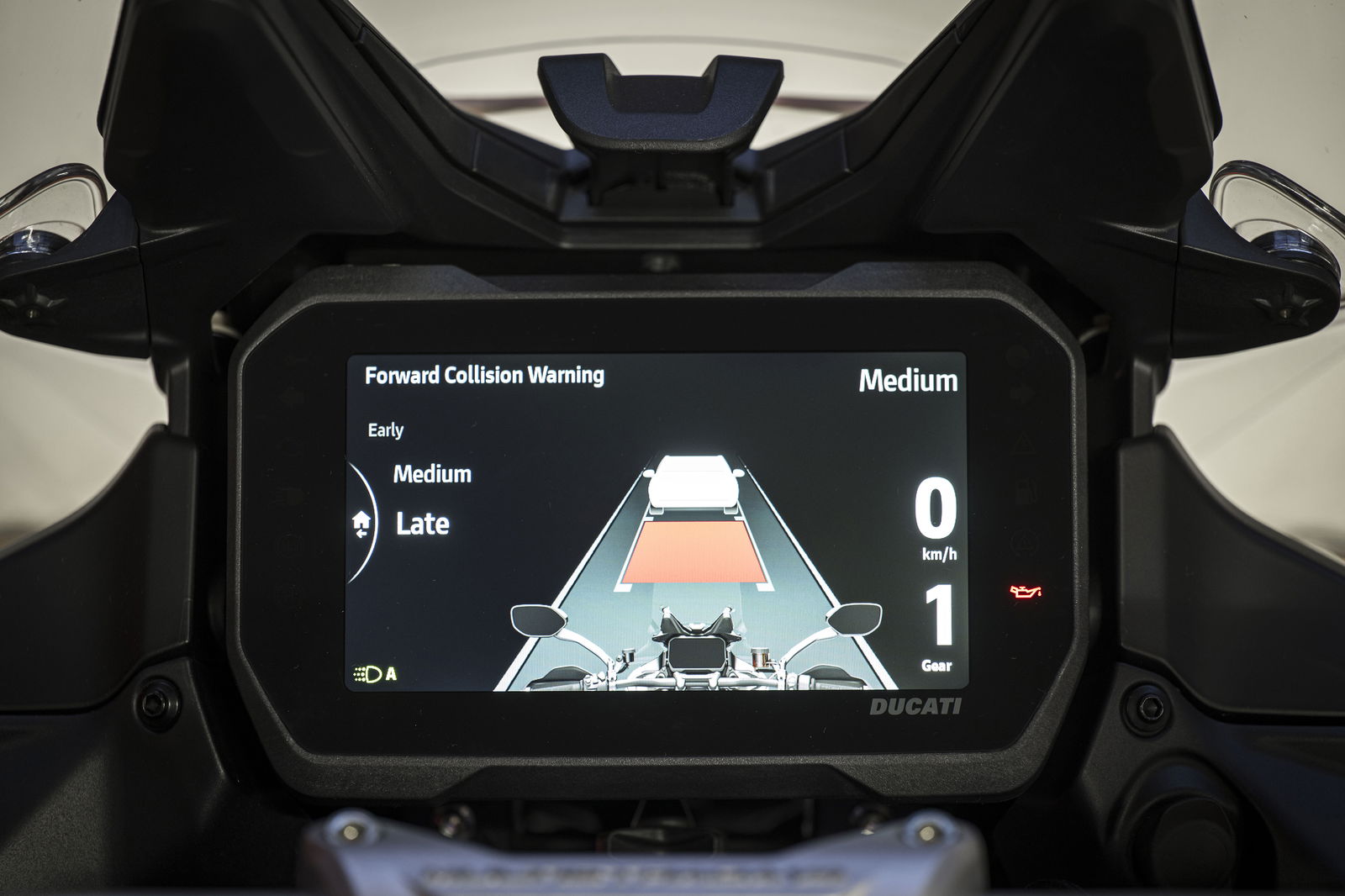
On the electronics front, the V4 S is more advanced than ever, with the Showa Skyhook suspension gaining a new bump detection system to help smooth out potholes. The radar system now gains a collision warning system which notifies the rider of a potential collision with a vehicle in front, which is on top of the existing features of blind spot detection and radar-assisted cruise control.

The Skyhook suspension system also gets a couple of new features, with an automatic lowering feature making life easier for shorties like me. It lowers the bike up to 30mm when the speed goes below 6mph, and raises the bike again when you hit 31mph. You can also manually activate a minimum preload feature, which drops the bike as low as it will go by holding down the suspension button on the left switchcube. You can only use this feature at a standstill, and both the minimum preload and auto-lowering are only available on the S versions of the Multistrada V4.
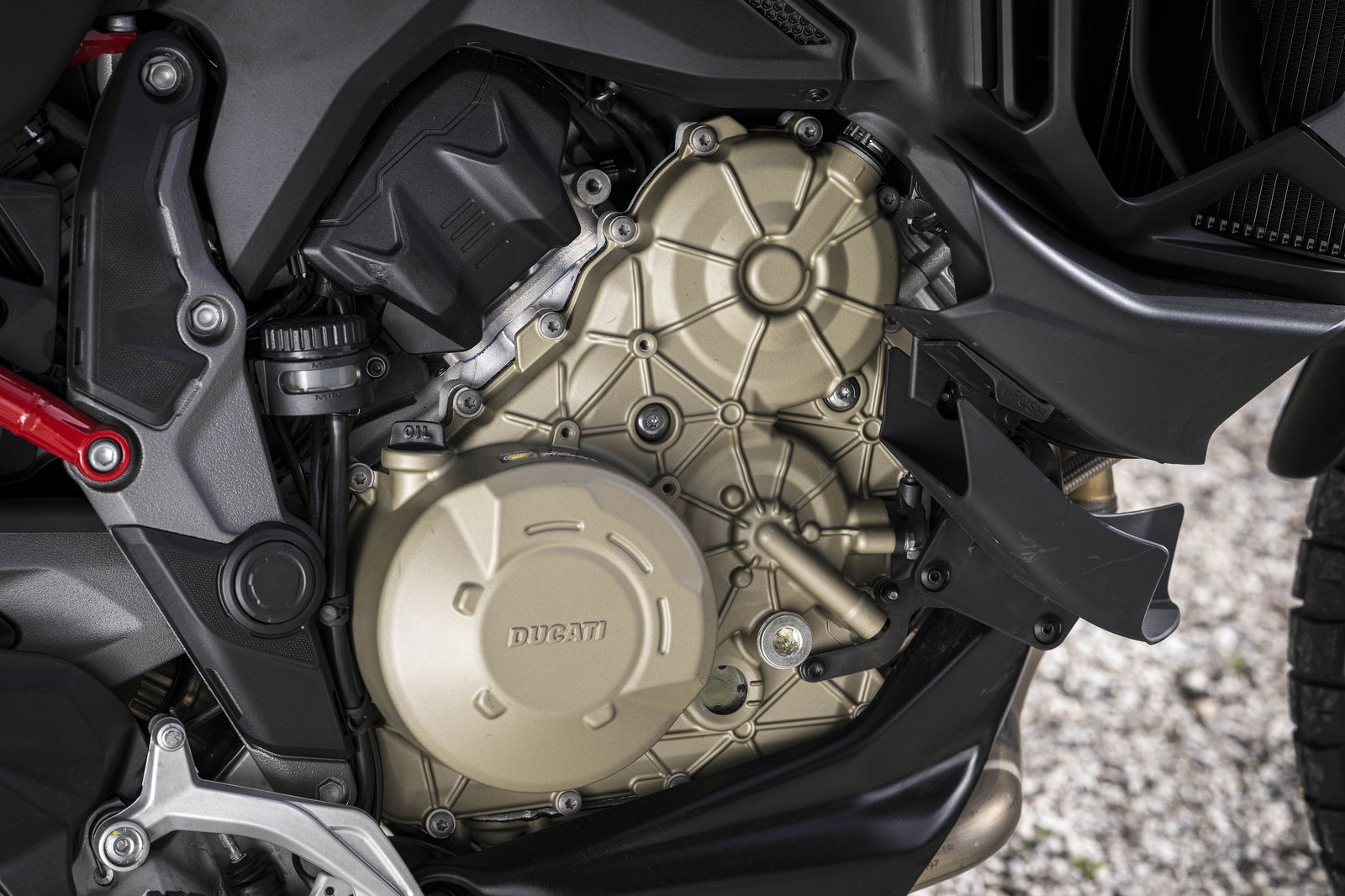
The final electronic upgrade of note is the Ducati Vehicle Observer (DVO) which links 70 sensors to the bike’s IMU and manages the ABS, traction control and wheelie control based on how the bike is being ridden. In short, when you’re pushing hard the bike ABS, TC and wheelie control are optimised for the way you ride, while the Skyhook suspension also adjusts based on the conditions and riding style.
And if you’re wondering why I’ve not listed all 40 or so changes I mentioned above, it’s because the review would already be too long!
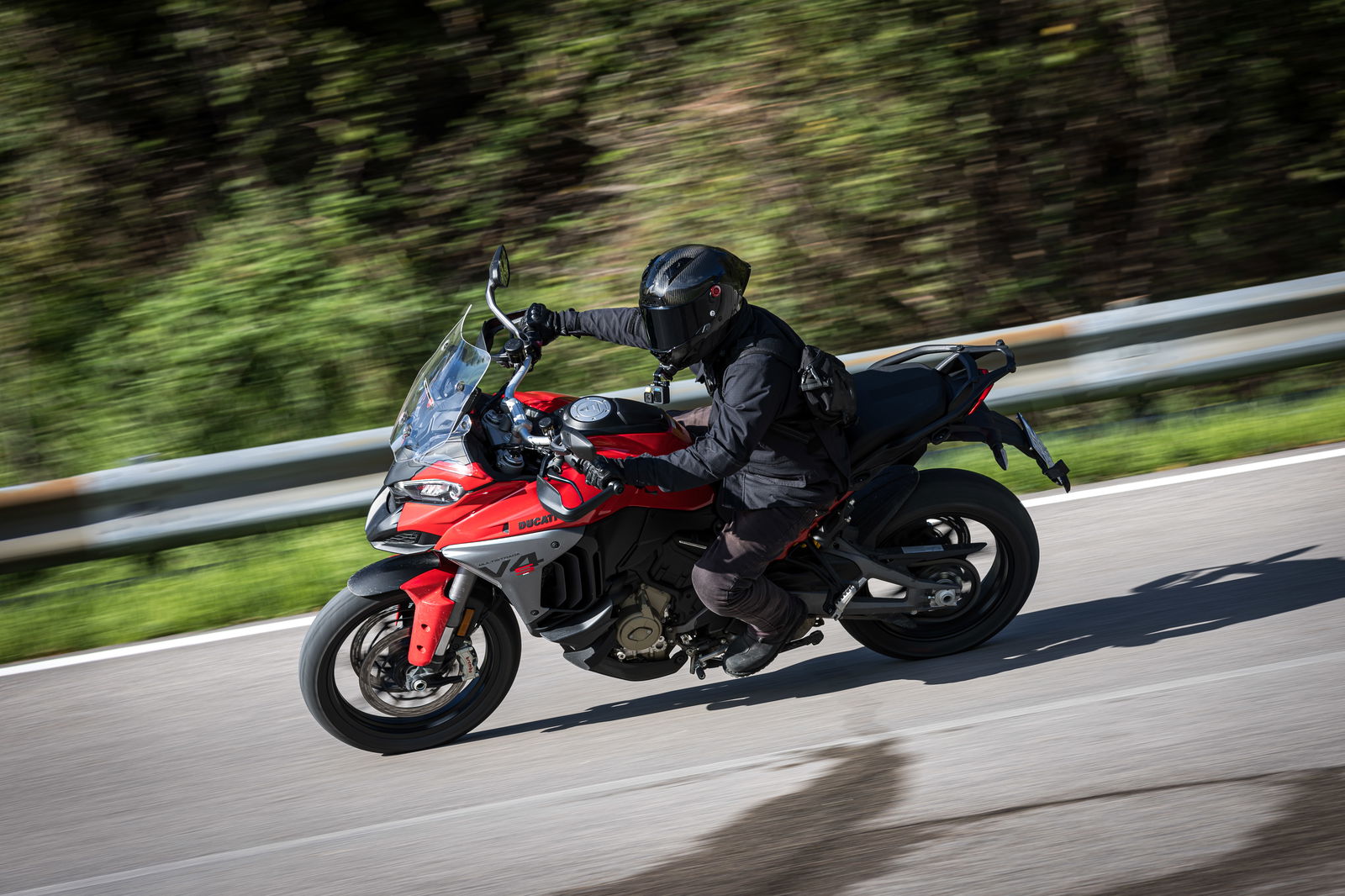
What’s it like to ride
The launch ride for this bike wasn’t the longest I’ve experienced, being around 150 miles in total, but it was over varied roads meaning we took in everything you’d experience in the real world. Ducati’s team also seemed to go out of their way to seek out some of the most heavily subsided and broken roads I’ve ever ridden on, making this a tough test for Ducati’s biggest bike.

After spending the day with the big Multi’, it’s still in my mind the best handling and fastest of all the 1,000cc and over long-distance tourers. It’s ludicrously quick on the road, giving you instant access to otherworldly amounts of acceleration thanks to the V4 engine. On-road and off-road handling also receive a shot in the arm thanks to lighter rims which slash the unsprung weight. The new bike also offers you a more refined and composed ride thanks to the sporty chassis and updated Showa suspension. And it’s the suspension that is the first thing I’m noticing a difference in as we hammer along some extremely bumpy Italian backroads. The Skyhook system on the 2025 Multistrada is defined by the DSS EVO control strategy, which includes a new bump detection system. It’s a little like what used to happen on the Citroen DS from the 50s, 60s, and 1970s.
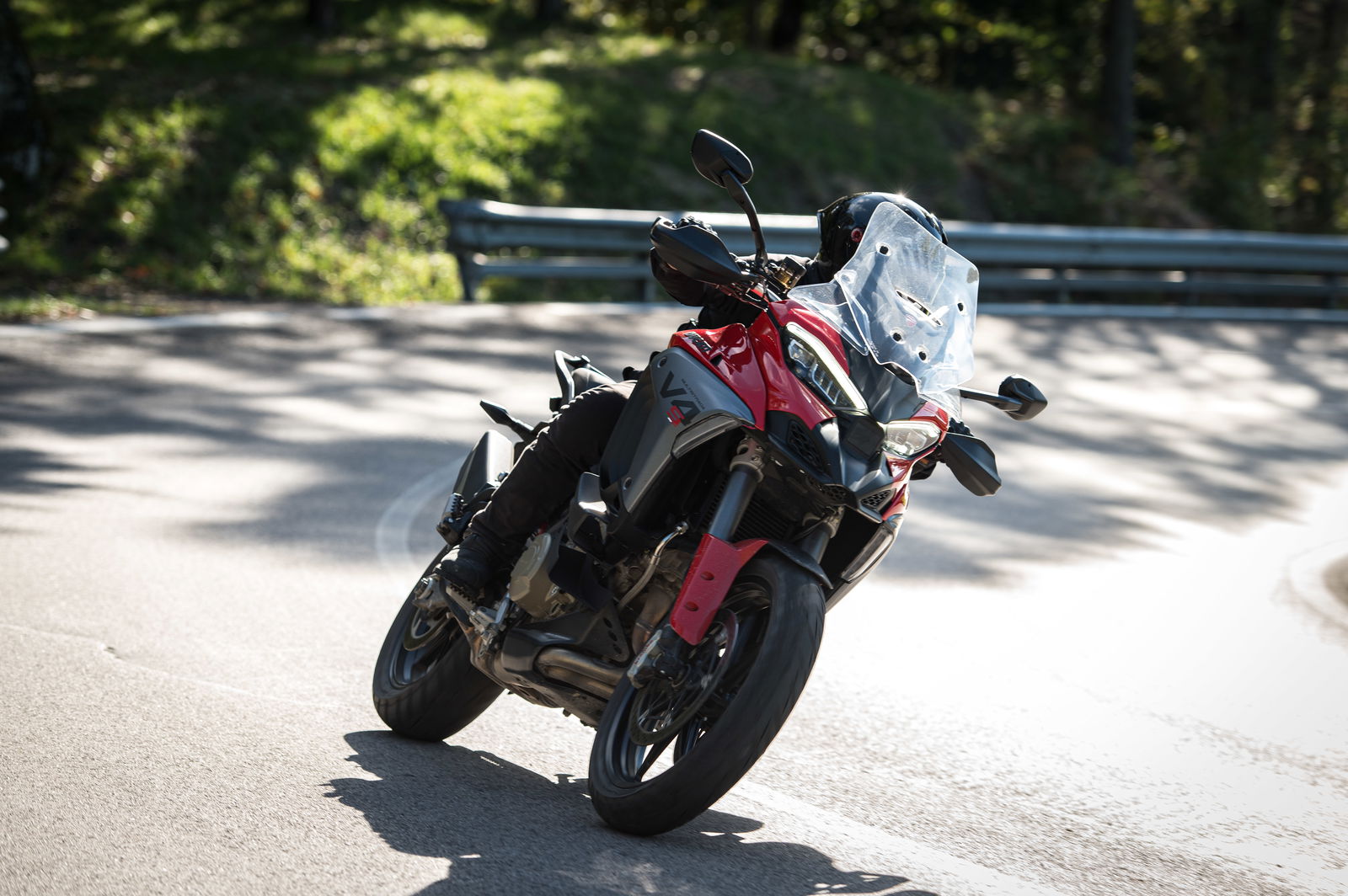
Simplifying the system massively, it uses inputs from the front wheels to prepare the rear wheel for a bump. The front wheels hit the bump and registering its size, and then this data is used to ensure the rear shock has appropriate settings to deal with the incoming impact. It works too, as I find myself tensing up for bumps and potholes which turn out to be nothing more than a flutter as the bike dances over them unperturbed. It not only makes the Multi’ comfier on uneven roads, but it also makes it faster as I’m not having to back off to save myself from being flung out of the seat, while the bike is less prone to bucking, weaving and generally squirming about.
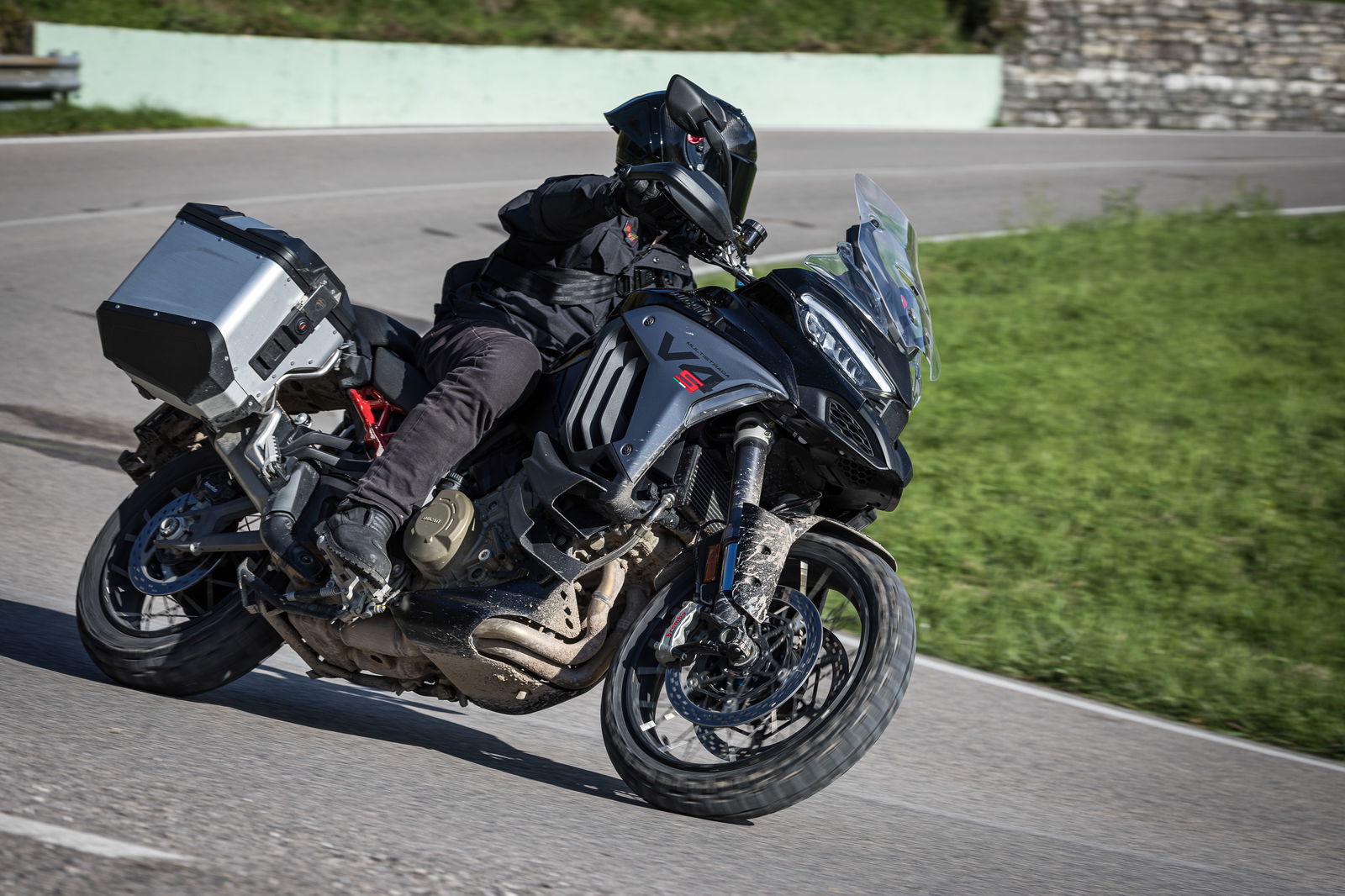
The new automatic lowering device is another handy tool, and one we are seeing more often on big adventure tourers. Like the system found on the Harley-Davidson Pan America 1250 Special, it dials out the preload from the suspension when it senses you pulling up to stop, and, in the case of the Ducati, drops the bike by as much as 30mm. Obviously for a rider like myself, being five foot seven inches in height, a system like this is a very helpful addition, and I’m happy to report that its implementation is such that you can’t feel it working, either when the bike is lowered or when it is raised to its normal position again. You can also use the minimum preload feature, which bleeds all the preload from the rear shock if you press and hold the suspension button on the left handlebar. This results in the rear of the bike dropping much more than with the automated system and would make it much easier to allow a pillion to clamber aboard the bike - again, it’ll be a godsend for shorter riders.
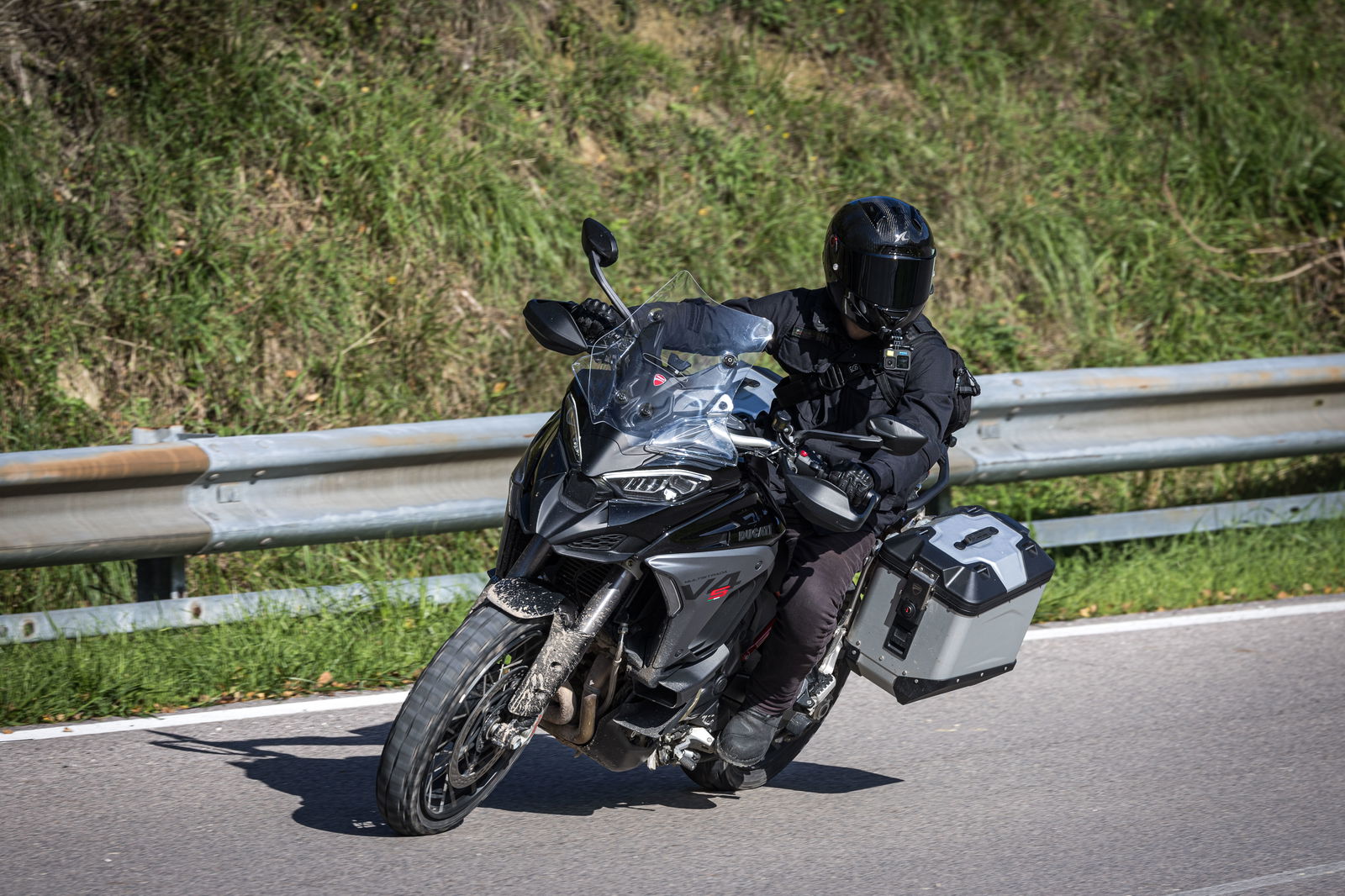
Another new feature for this year that I’m noticing, and liking quite a lot, is the linked braking system. In particular, I’m enjoying the reversed front-to-rear link, which applies a small amount of front brake when the rear brake is applied. It’s not something you’ll use much for faster riding, although when casually pootling along leaning on the system makes riding feel smoother and more refined. It’s not winning everyone on the launch ride over, though, and it seems like there is a 50/50 split between journalists who like it versus those who don’t. And if you aren’t a fan you can simply turn the system off, or opt for one of the other ABS modes - the rear-to-front CBS is only active when ABS mode 3 is being used.
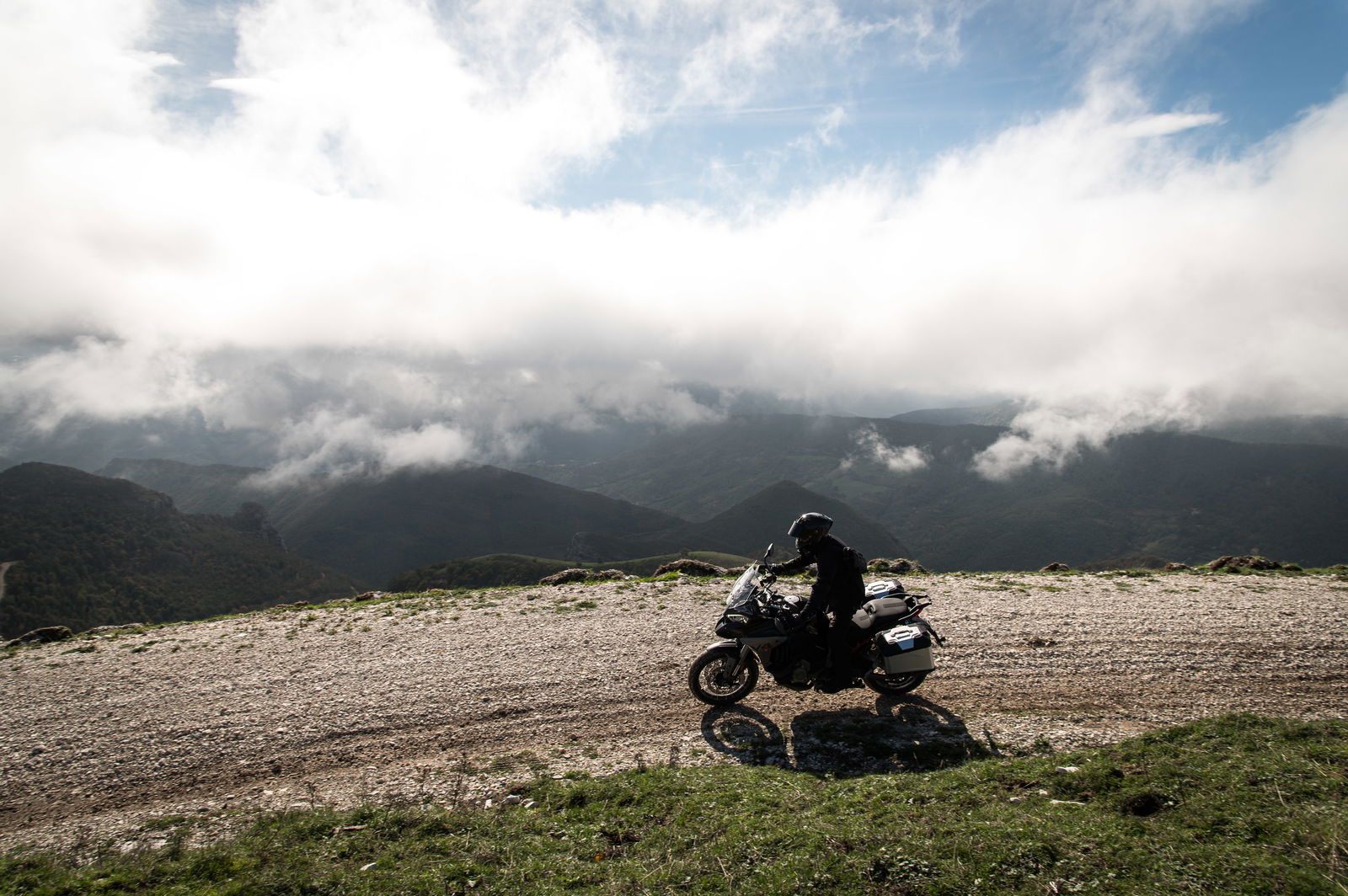
The launch ride on the new Multistrada also included taking a more off-road inclined bike on a short (around 10 miles or so) dirt section. For this the bikes were shod with the new lighter spoked wheels and road-legal knobblies, they also gained the aluminium adventure-spec panniers.
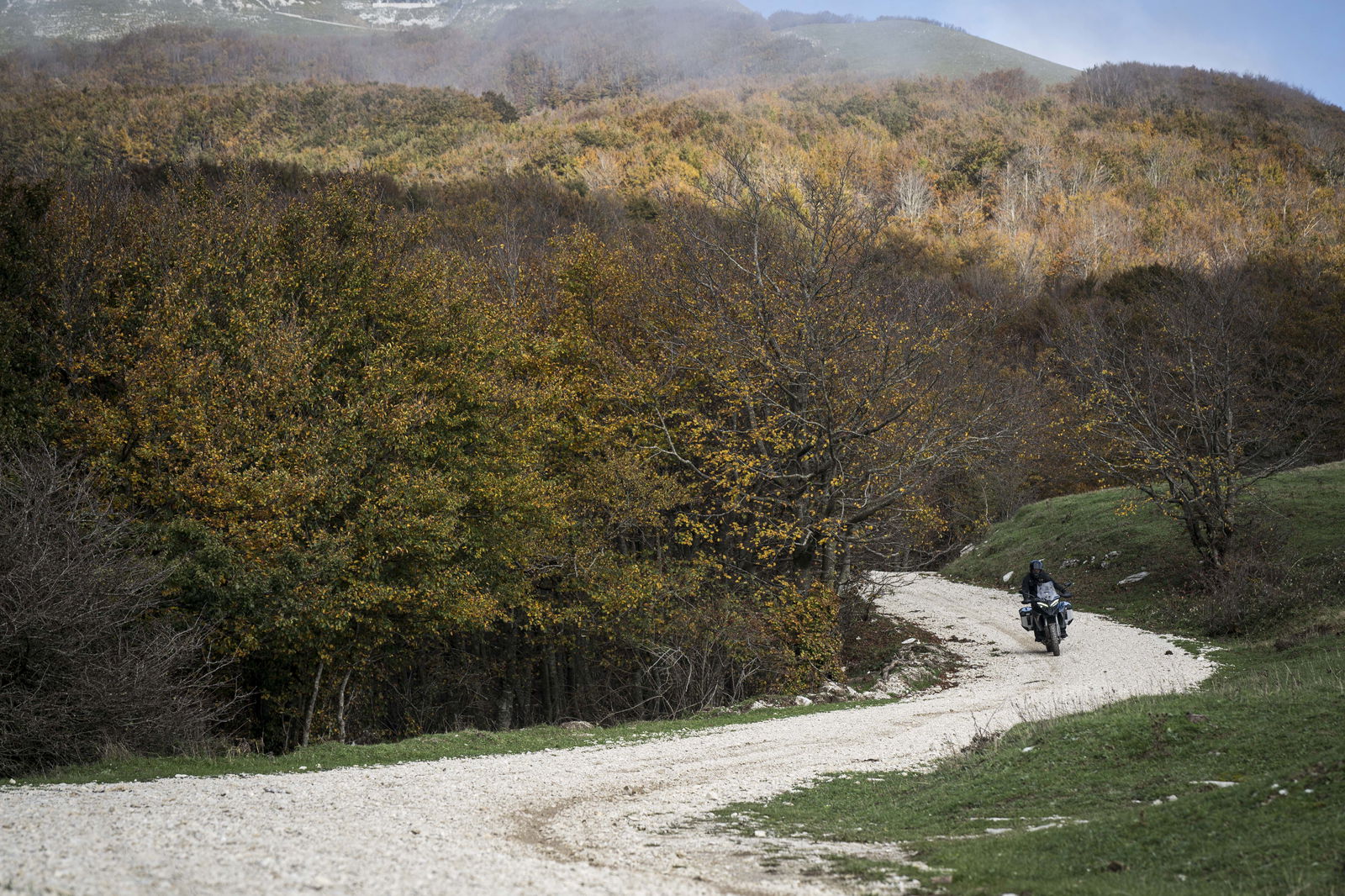
If you’ve been riding on the road all day (and quite often at excessive speeds) it takes a bit of time to switch to an off-road mentality. Thankfully the picturesque fire trail Ducati has lined up for us starts off with some easy-going hard-packed gravel, giving me a chance to get my brain clicked into gear. I’ve got my bike set in the Enduro mode, with traction control set to level one (there are three levels including off) and ABS to the rear wheel disengaged.
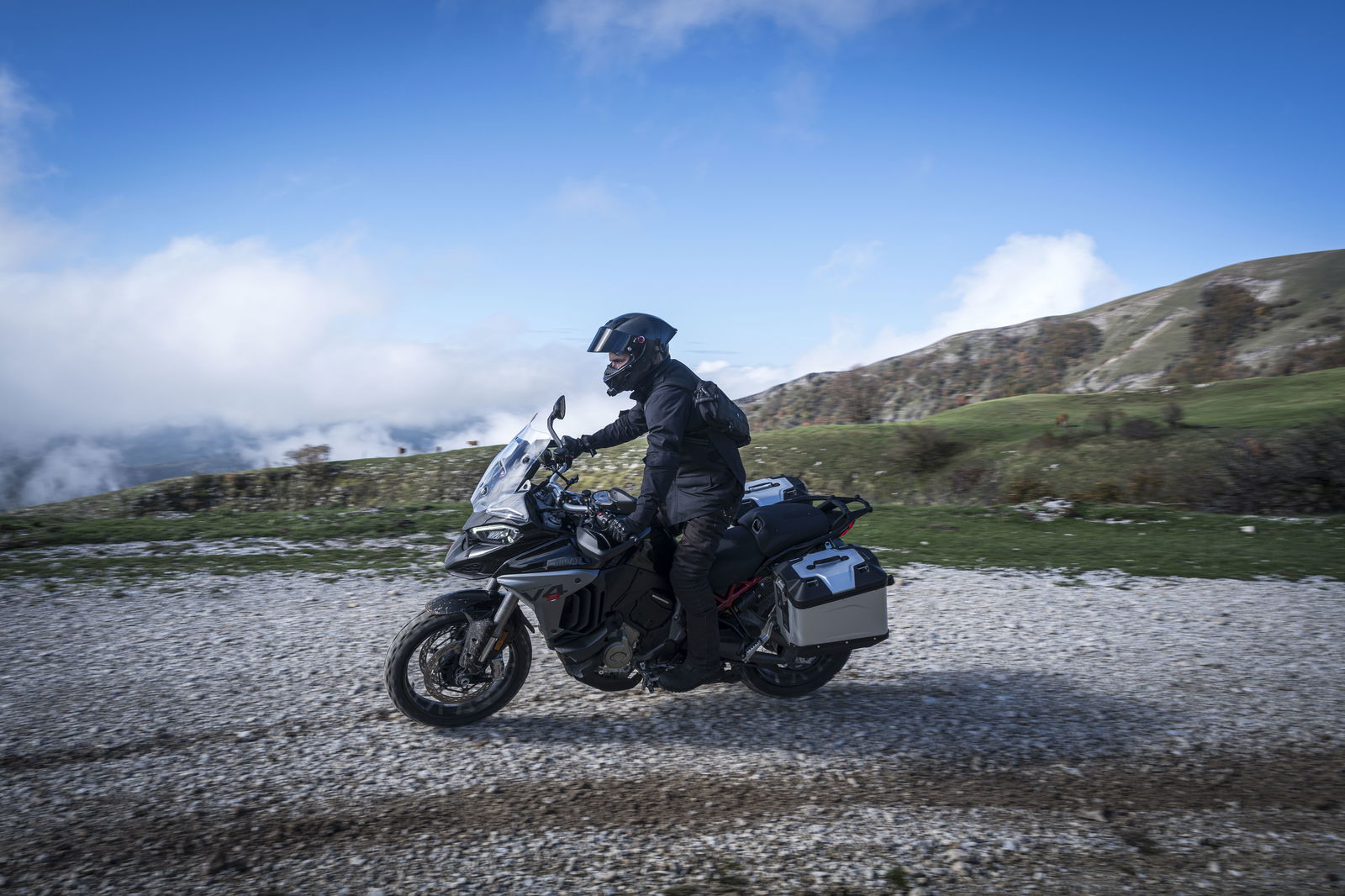
The power is pegged back at 110bhp, and even with the lowest traction control setting dialled in, I’m still having to ask a lot of my right wrist to get the back end to step out around corners. In this mode, the Multistrada actually feels very easy to ride. The suspension is now backed off and almost as soft as it can go, and despite its 231kg weight (wet but no fuel), it feels surprisingly nimble and light on its feet. Even some deeper sections of softer terrain can do little to upset the Italian applecart.
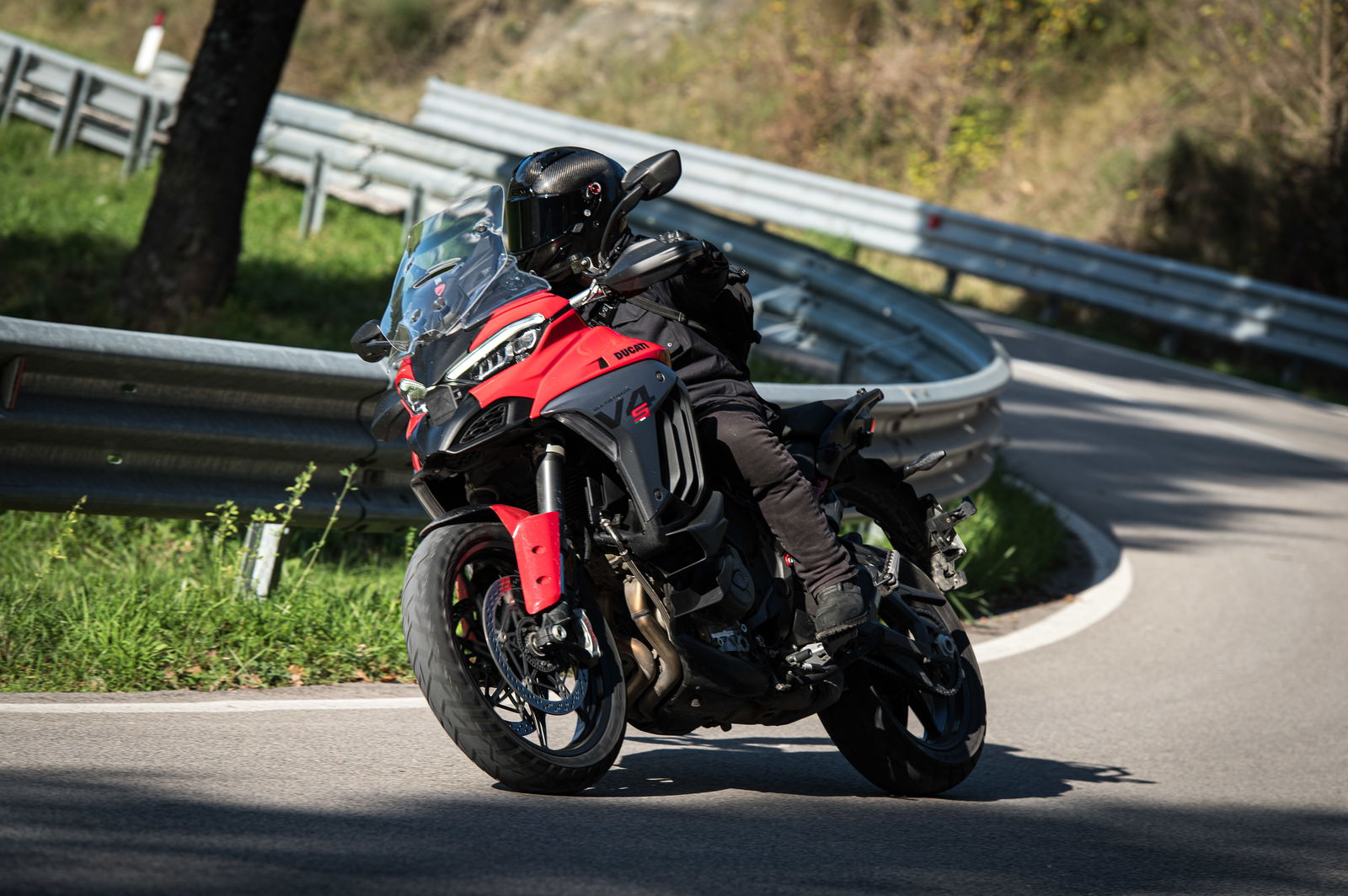
After the off-road taster was complete we are back on the asphalt as we head to what is promised to be the highlight of the day. The route we’ve been riding has shadowed some of the famous Mille Miglia course, and one particular section, close to the launch hotel in the pretty town of Gubbio, saw us riding the final part of the Trofeo Luigi Fagioli hillclimb course.

It is a stunning section of road, with the part we used for some content capture being particularly awe-inspiring. It’s the kind of road you look down on as you approach it that gets you properly fired up for a ride. Perfect asphalt, switchback hairpins and camber in all the right places. It’s the kind of road that the big Multistrada was made for and highlighted beautifully the chassis, engine and brakes of the bike. If you are looking for the sweetest handling and quickest of all the big ADVs for on-road riding, the Multistrada is a bike that is impossible to overlook. It even makes you question why we have sportsbike and supernakeds at all, when you can have access to similar levels of performance and ability all wrapped up in a comfy long-distance tourer - and with more technology and safety features than ever before.

Is the Ducati Collision Warning System any good?
It’s a funny one this, as to truly test the system you have to put yourself in a bit of danger, not something I’m too inclined to do. Explaining the system is easy, the radar detects when a vehicle in front is slowing down and if the rider doesn’t react it’ll flash all kinds of warnings on the dash to jolt you into action. That’s all well and good if it’s the bike’s TFT dash that you are looking at. If it’s something else that has caught your eye, it’s not much help.
It's similar to the system on the Tracer 9 GT +, although with the Yamaha collision avoidance system, the bike will actually apply more braking force if you’re already braking but the system deems that more deceleration is required. I suppose that any kind of warning of an impending collision is a good thing to have, although I think that something a little more proactive, as found on the top-spec Tracer 9, could perhaps have been a more helpful addition.

Should you buy the Multistrada V4 S
The new and updated Multistrada might not be a vast facelift model that is instantly recognisable from the previous generation, and instead, all of the changes to the bike are invisible up to the point that you get on it and ride. From the rider’s seat, though, the multitude of changes for the 2025 model year reinforces the bike's ability, making it comfier, easier to ride, and potentially faster than ever on the public road.

Those headlines do come at a price though, because as tested the road-going V4 S comes in at £23,595, while the bike used for the off-road section will cost £25,925 including the add-ons. A sizeable chunk of change that may be, but compared to the competition from KTM, BMW and Triumph, it’s not an out-of-this-world figure. And if you take into account just how good the new bike is for fast on-road riding, it really stands out against the crowd of wannabe rally bikes as the one to go for. It’s also arguably the best-looking, but then again it would be, wouldn’t it?
2024 Ducati Multistrada V4 S spec
Engine | Ducati V4 Granturismo, V4, 4 valves per cylinder, liquid cooled |
Capacity | 1.158 cc |
Power | 125 kW (170 hp) @ 10,750 rpm |
Torque | 124 Nm (12,6 kgm) @ 9,000 rpm |
Gearbox | 6 speed with Ducati Quick Shift up/down |
Clutch | Multiplate clutch with hydraulic control. Self-servo action on drive, slipper action on over-run |
Frame | Aluminum monocoque frame |
Suspension (F) | Ø 50 mm fully adjustable USD fork, electronic compression and rebound damping adjustment with Ducati Skyhook Suspension, integrated stroke sensor. |
Suspension (R) | Fully adjustable monoshock, electronic adjustment with Ducati Skyhook Suspension, automatic fast lowering device between 10km/h and 50km/h, aluminium double-sided swingarm |
Weight | 232 kg - wet no fuel |
Seat height | 840 mm - 860 mm |
Fuel capacity | 22 litre |
